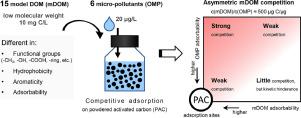Water Research ( IF 11.4 ) Pub Date : 2021-07-18 , DOI: 10.1016/j.watres.2021.117443 Qi Wang 1 , Raja-Louisa Mitchell 2 , Roberta Hofman 3 , Jianwei Yu 4 , Min Yang 4 , Luuk C Rietveld 5 , Frederik Zietzschmann 6

|
Low molecular weight (LMW) dissolved organic matter (DOM) is the predominant competitor for adsorption sites against organic micropollutants (OMPs) in activated carbon adsorption. However, top-down approaches using highly complex mixtures of real water DOM do not allow to concisely examine the impacts of specific LMW DOM molecular properties on competitive adsorption. Therefore, we followed a bottom-up approach using fifteen model compounds (mDOM) to elucidate how important DOM characteristics, including hydrophobicity and unsaturated structures (ring, double/triple bond), impact competitiveness. Large concentration asymmetry (~500 μg DOC/μg OMP) made mDOM compounds, which were overall less preferentially adsorbed than OMPs, become competitive against OMPs and inhibit OMP adsorption kinetics by pre-occupation of adsorption sites. Our results revealed that both hydrophobicity interactions and π-interactions increased mDOM competitiveness, while π-interactions outweighed hydrophobic interactions. However, π-interactions could not be satisfactorily evaluated with a parameter such as specific ultraviolet absorbance (SUVA) due to interferences of carboxyl groups in aromatic mDOMs. Instead, mDOM adsorbability, described by mDOM adsorption capacity, proved to be a comprehensive indicator for mDOM competitiveness. To our knowledge, this is the first study that systematically clarifies the impacts of intricately interacting molecular properties on DOM adsorption and the related competition against OMP adsorption. DOM adsorbability may inspire a new fractionation, and assist the further isolation, identification and detailed characterization of LMW DOM competitors in real DOM-containing waters.
中文翻译:

低分子量模型竞争对手的特性如何影响在实际不对称浓度下有机微污染物吸附到活性炭上
低分子量 (LMW) 溶解有机物 (DOM) 是活性炭吸附中针对有机微污染物 (OMP) 的吸附位点的主要竞争者。然而,使用高度复杂的真实水 DOM 混合物的自上而下的方法不允许简明地检查特定 LMW DOM 分子特性对竞争吸附的影响。因此,我们采用自下而上的方法,使用 15 种模型化合物 (mDOM) 来阐明 DOM 特征,包括疏水性和不饱和结构(环、双键/三键)对竞争力的影响。大浓度不对称性(~500 μg DOC/μg OMP)使 mDOM 化合物总体上不如 OMP 优先吸附,变得与 OMP 竞争并通过预先占据吸附位点抑制 OMP 吸附动力学。我们的结果表明疏水性相互作用和 π 相互作用都增加了 mDOM 的竞争力,而 π 相互作用超过了疏水相互作用。然而,由于芳香族 mDOM 中羧基的干扰,无法用比紫外吸收率 (SUVA) 等参数令人满意地评估 π 相互作用。相反,由 mDOM 吸附能力描述的 mDOM 吸附能力被证明是 mDOM 竞争力的综合指标。据我们所知,这是第一项系统阐明复杂相互作用的分子特性对 DOM 吸附的影响以及与 OMP 吸附的相关竞争的研究。DOM 吸附性可能会激发新的分馏,并有助于进一步分离,











































 京公网安备 11010802027423号
京公网安备 11010802027423号